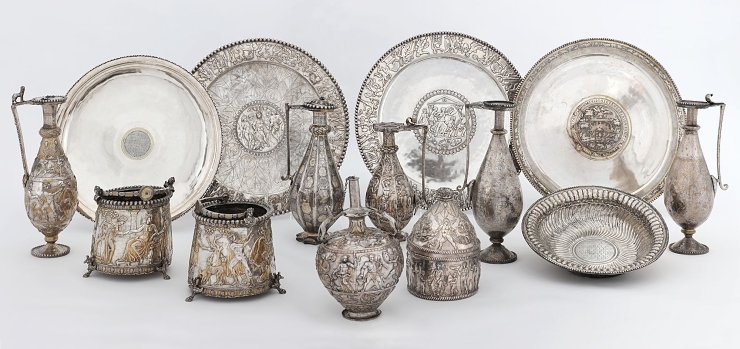Taková miska na kompot  ale pěkný nález a super snaha Maďarska:-)
ale pěkný nález a super snaha Maďarska:-)
19.11.1980 Seuso Treasure
Categories: Treasures , Calendar

 At the end of 1980, the corpse of archaeologist József Sümegh was discovered in a cellar on Köszár Hill, where he had committed suicide. He is said to have discovered about forty silver artefacts, including large wrought-iron bowls, jars and other decorated vessels. The so-called Seuso treasure was recovered by Hungary six years ago.
At the end of 1980, the corpse of archaeologist József Sümegh was discovered in a cellar on Köszár Hill, where he had committed suicide. He is said to have discovered about forty silver artefacts, including large wrought-iron bowls, jars and other decorated vessels. The so-called Seuso treasure was recovered by Hungary six years ago.
This treasure dates back to the fourth century. It is linked to the aforementioned archaeologist and miner József Sümegh, who, according to some theories, discovered the rare Roman depot. The military police concluded that he committed suicide. But some locals said they had ignored testimony that other people had been in the depot.
A Hungarian archaeologist is said to have discovered about forty silver objects. These included hammered bowls, jugs and other vessels of great value. However, nothing was found after his death. According to some theories, József Sümegh's death is linked to the disappearance of the depot. The most daring theories are that the archaeologist was murdered for the treasure and the objects were sold to the West with the help of the secret services.
In 1990, fourteen pieces of crockery were to be sold through Sotheby's auction house in New York. Lord Northampton of England was listed as the owner. The treasure was mysteriously smuggled across the border during the socialist era and ended up in a private collection in London. Before the auction, however, it turned out that the Lebanese documents for the objects, worth some forty million pounds, were forged.
Budapest immediately turned to the courts in New York. They acquired part of the treasure in 2015. Specifically, seven silver vessels worth over 412 million crowns.
The public was able to see these art treasures for free in the parliament building. "Our family silver has returned to the country," said Hungarian Prime Minister Viktor Orbán at the time.
And why the name Seuso? Because that word is on a nine-kilogram bowl with a diameter of seventy centimetres, which is part of the treasure. "May these bowls serve you, Seuso, and your descendants," the bowl reads.
Seuso was probably a very rich man who lived near Balaton. At that time, it was Lake Pelso. Historians say he hid the treasure when the Roman Empire occupied the area. At that time, the Germanic tribes made a series of attacks.
Sources: www.respekt.cz, www.novinky.cz, https://mnm.hu/
The article is included in categories:
Post
Jen bych doplnil, že se nejedná o nádoby na guláš přip. halászlé ale jedná se o nádoby používané k mytí a kosmetickým potřebám.
Celý depot je římského původu a onen Seuso byl bohatý vojevůdce a provinční správce. Poklad byl ukryt v pozdní římské Panonii, což je současné území Maďarska.
(zdroj - Maďarské museum)
Tedy v podstatě se Maďaři chlubí cizím peřím.
Depot je tak úchvatný, že člověk si rád dohledá relevantní informace, aby se dozvěděl více.
Je to vážně nádherná práce.
https://en.m.wikipedia.org/wiki/Seuso_Treasure
Trošku jiné informace.







